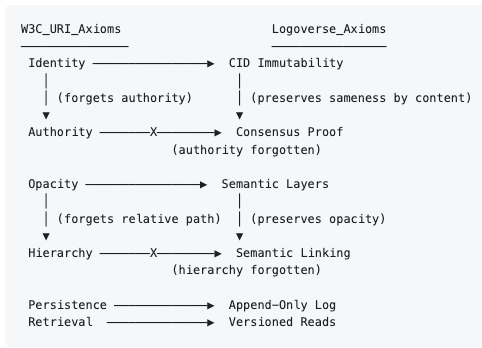Logoverse vs W3C URI Axioms
Tim Berners-Lee’s early axioms about URIs still shape how we think about identity, persistence, and semantics on the web. But what if we re-examined those axioms in the light of content addressing, append-only registries, and executable semantics?
A recent gist compares W3C’s URI axioms with a new set of Logoverse axioms — drawing out where they align, diverge, and evolve.

The string diagram makes clear that Logoverse is defined relative to the W3C axioms: it preserves core principles like identity, opacity, and persistence, while forgetting authority and hierarchical paths. What remains is a content-addressable, consensus-anchored structure — a reinterpretation of the web’s foundation, not a rejection of it.
Why It Matters
- Stronger guarantees: CIDs enforce immutability and reproducibility.
- Semantics first: JSON-LD, SVG, and Render layers are baked into the model.
- Censorship resistance: Identity is based on content, not ownership or policy.
- Provenance: Append-only registries preserve history by design.
Open Questions
- Can append-only registries scale to global use?
- How does this integrate with existing URI/HTTP infrastructure?
- How do developers track the “latest” object when everything is versioned?
Closing Thoughts
The Logoverse axioms don’t discard Berners-Lee’s URI principles — they reinterpret them. They aim to make immutability, provenance, and executable semantics first-class citizens in the web’s architecture.
It’s not just about naming things anymore. It’s about making those names provable, persistent, and composable.